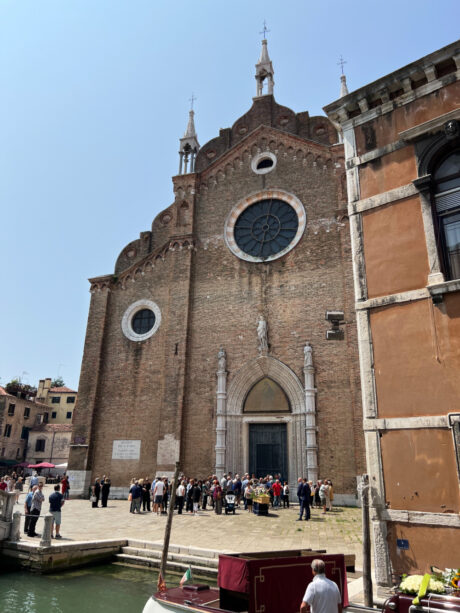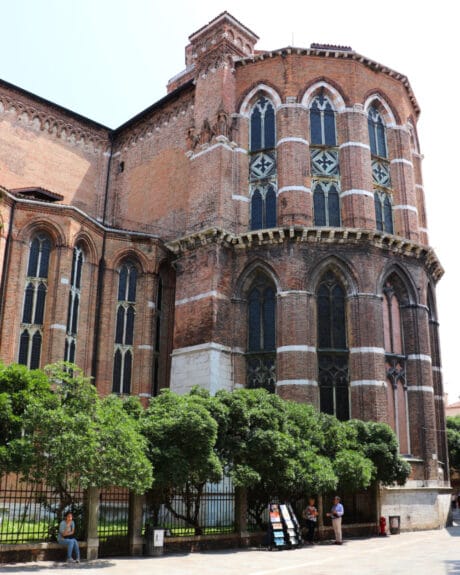Visit the Gothic Frari Church to see some of the best art in Venice, including works by Titian, Bellini, and Donatello. Tickets are easy to buy and cheap.
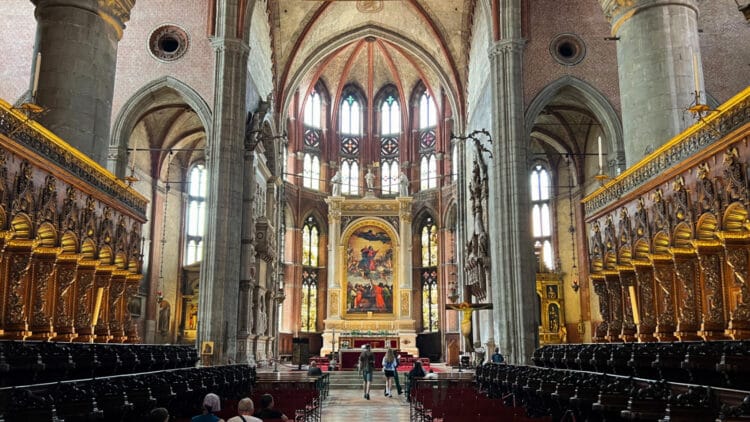
The Basilica of Santa Maria Gloriosa dei Frari, commonly referred to simply as the Frari, is the largest Gothic church in Venice. In Venice, it is second only to San Marco but offers a peerless opportunity to encounter Venetian art in situ. Its masterpieces by Titian, Bellini, Donatello, and others are not on museum walls but are part of a still-functioning sacred space. Whether you visit for the history, the art, the craftsmanship, or for devotion, the Frari rewards visitors as one of Venice’s true treasures. In contrast to San Marco and Doge’s Palace, admission is cheap and easy even on busy days. Buy tickets directly at the Frari Church — no online sales or time-slot reservations.
Gothic Basilica of Santa Maria Gloriosa dei Frari
Hidden in the heart of Venice’s San Polo district, the Basilica di Santa Maria Gloriosa dei Frari is one of the city’s most extraordinary places for encountering Gothic, Renaissance, and Baroque art. This working church is full of masterpieces by some of Italy’s greatest artists. This is not a museum — its artworks were created to serve a devotional purpose — but it offers one of the richest artistic experiences in all of Venice.
The large brick church follows a Latin cross, triple-nave basilica floor plan. Typically, for a Franciscan church, the exterior is largely unadorned, while the interior is vast, with space for a large congregation. The current church was mostly completed by 1500, although work had already started around 1330 and much of it is from the 14th century.
Tourists enter from the side, near the bell tower. It is after San Marco Basilica, the tallest campanile in Venice, confirming that the ground here is not suitable for tall structures. The church itself is vast — measuring 102 m long, up to 48 m wide, and 28 m high.
See Top Artworks in the Frari in Venice

The Gothic church is impressive but the main reason to visit the Frari is the art of its 17 monumental altars, numerous tombs, and chapels. The artistic highlights are the two paintings by Titian, but some of the tombs are also very interesting. The rood screen and wooden choir stalls are the only examples still in position in any major church in Italy.
What sets the Frari apart is the unity of its space. The tall Gothic nave, the filtered light, and the aged surfaces contribute to an atmosphere that enhances the art. Paintings and sculptures here are not isolated exhibits but integral parts of the devotional life of the building.
Visitors don’t just see great works. You’ll experience them as they were meant to be seen: in a living space where faith and beauty are inseparable. It also offers an opportunity to admire and compare in situ Paolo Veneziano’s Gothic Madonna and Child with the Renaissance interpretations by Giovanni Bellini and Titian.
Titian’s “Assumption of the Virgin”

The first thing most visitors notice is the massive altarpiece in the presbytery behind the high altar: the Assumption of the Virgin, painted between 1516 and 1518 by Tiziano Vecellio, or Titian.
The painting shows the Virgin Mary rising into heaven in a swirl of golden light and crimson robes, surrounded by a ring of angels. God the Father is ready to receive her, with an angel handing him a crown for her coronation.
Below her, the apostles react with awe, their arms raised, their faces lit with emotion. Although all twelve are present, usually, only Peter (seated and praying) and John (in red, beardless) are identified. Titian signed the work “Titianus” (on the stone sarcophagus below Peter).
Titian’s Assumption was a groundbreaking work in Venetian art. Titian was still in his twenties when he received the commission, yet he brought an unprecedented sense of drama and unity to the composition of his first major public commission. The dynamic structure, expressive gestures, and bold use of color marked a turning point in Venetian painting. It remains one of the most important altarpieces in Italy and one of Titian’s greatest achievements.
The friars were reportedly initially not happy with the work. The Venetians were slower to adapt to the new art ideas of the Florentine and Roman Renaissance. Not only were the bold colors and dynamic movements disturbing, but more seriously, the apostles were larger than the Virgin. It is often claimed that Franciscans only accepted and paid for the painting after Emperor Charles V offered to buy it. (Unfortunately, the story is almost certainly untrue. The imperial ambassador, who should have made this offer, was out of the city at the time. However, Charles V was an important patron, which explains his name on Titian’s grave monument in the nave.)
See Titian’s Assumption of the Virgin in Situ in the Frari
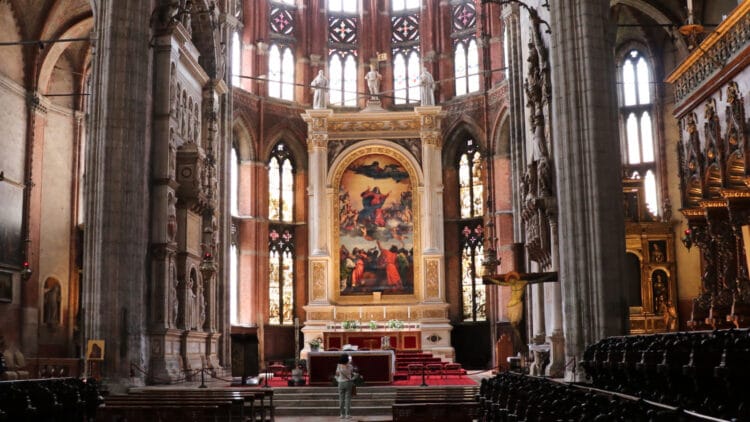
At over 22 feet tall, Titian’s Assumption of the Virgin dominates the church’s central axis and floods the apse with color and movement. In a city fond of large paintings, this is the largest altar painting in Venice. It had to be — the church is physically big and the congregation had to see it from a distance. The full measurements are 690 cm x 360 cm (270 in by 140 in).
After three centuries in the Frari, the painting was moved to the Galleria dell’Accademia in 1817. Although a new room with a higher ceiling was specifically constructed, the dirty painting was badly lit. Still, Canova described it as the greatest painting in the world, while Oscar Wilde claimed it was certainly the best picture in Italy.
After a century in the museum, Titian’s Assumption of the Virgin returned to the Frari Church in 1919. It returned to its original position behind the main altar. The stained-glass windows of the presbytery were removed to improve the lighting, allowing visitors to fully appreciate the beauty of Titian’s masterpiece.
Titian’s “Pesaro Madonna”

In the left nave, near the main entrance, hangs another of Titian’s masterpieces: the Pesaro Madonna, completed around 1526. Although much smaller than the Assumption, it was just as revolutionary. Instead of placing the Madonna and Child at the physical center, Titian sets them dramatically off to the upper right. A diagonal flow leads the viewer’s eye from the kneeling donor, Jacopo Pesaro, to the Virgin above, with St Peter (center) and St Francis (in monk’s habit) positioned along the way.
This asymmetrical arrangement was highly innovative and would influence religious painting for generations. The colors are vivid, the faces individualized, and the architectural setting grand yet welcoming. The painting balances formality with human warmth and spiritual depth.
Giovanni Bellini’s “Madonna and Child with Saints”
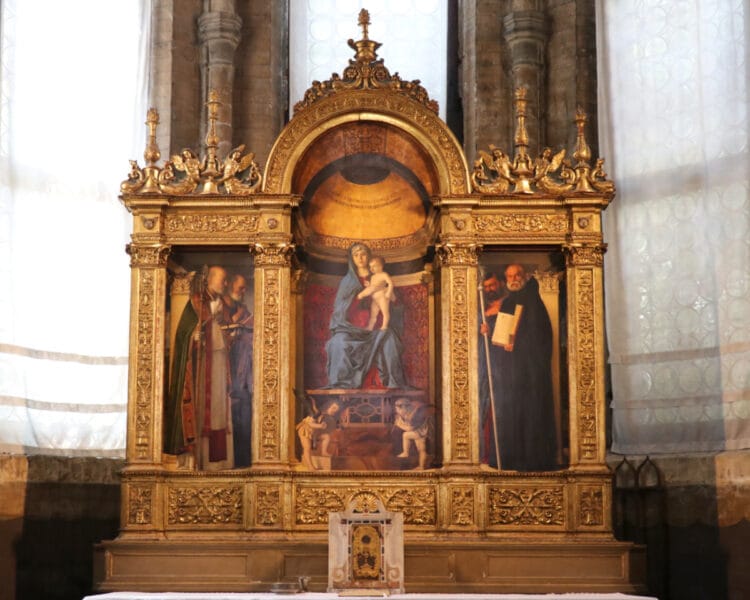
Tucked away in the church’s sacristy is a quieter but equally powerful work: Giovanni Bellini’s Madonna and Child with Saints, also known as the Frari Triptych. Painted in 1488, it marks one of Bellini’s last great altarpieces. The composition is classical and symmetrical, with the Virgin seated beneath an arch, flanked by saints. Christ rests calmly in her lap.
Where Titian’s painting dazzles with energy, Bellini’s invites contemplation. The soft light, harmonious colors, and architectural clarity create a sense of peace and stability. The figures are idealized yet approachable, and the mood is meditative.
Bellini’s work represents the Venetian Renaissance at its most refined and serene. His pupil Titian broke with the style rules and prepared the way for Paolo Veronese and Tiepolo.
Paolo Veneziano “Madonna and Child”
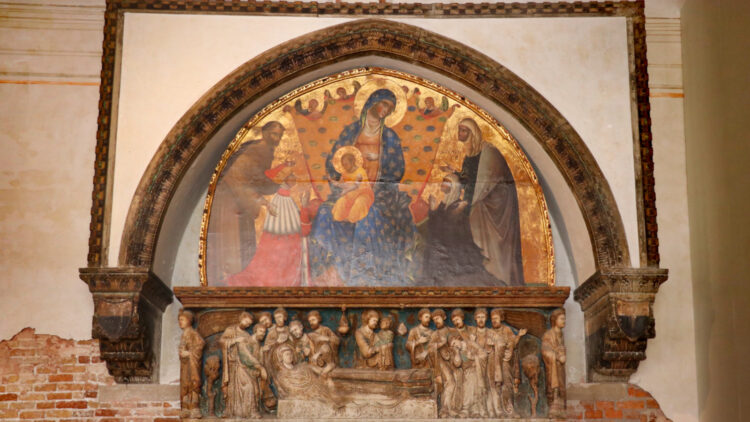
In the quiet chapter house, Paolo Veneziano’s Doge Francesco Dandolo and His Wife Presented to the Virgin by Saints Francis and Elizabeth, often shortened to Madonna and Child, offers a glimpse into the early roots of Venetian art.
The composition shows the reigning Doge Francesco Dandolo kneeling reverently before the Virgin Mary and Christ Child, enthroned at the center. Saint Francis of Assisi, the founder of the Franciscan order to which the Frari belongs, introduces the doge. On the other side, Saint Elizabeth of Hungary presents the doge’s wife, Elisabetta Contarini.
Painted in 1339 in a refined Gothic style with lingering Byzantine influences, the work reflects Paolo Veneziano’s signature use of graceful lines, luminous colors, and devotional intimacy. It is not just a portrait of piety but also a political image, showing the doge and his consort in eternal dialogue with the sacred. The gold background, stylized drapery, and delicate gestures give the panel a timeless, almost ethereal quality.
For visitors today, it offers a powerful link to the early history of Venice’s artistic identity, centuries before Titian would dominate the same sacred space.
Donatello’s Wooden Statue of St. John the Baptist

A striking wooden sculpture by Donatello of St. John the Baptist, carved around 1438, is in the chapel immediately to the right of the presbytery. The figure is gaunt, intense, and full of life. Donatello captures the prophet’s wilderness spirit with tousled hair, deep-set eyes, and a flowing robe that clings to his frame.
Unlike the polished marble statues of later eras, this piece has an expressive rawness. It reveals Donatello’s ability to convey spiritual power and emotional depth through naturalistic form. The wood, aged and darkened, adds to its dramatic effect. (It is similar in style to his Mary Magdalene, which was for centuries in the baptistry in Florence and is now in the Duomo Museum.)
St John the Baptist stands as one of the earliest Renaissance works in Venice and the only Donatello in the city. (However, it is only a 30-minute rain ride to see several Donatello sculptures at the Basilica of St Anthony in Padua.)
Funerary Monument to Titian
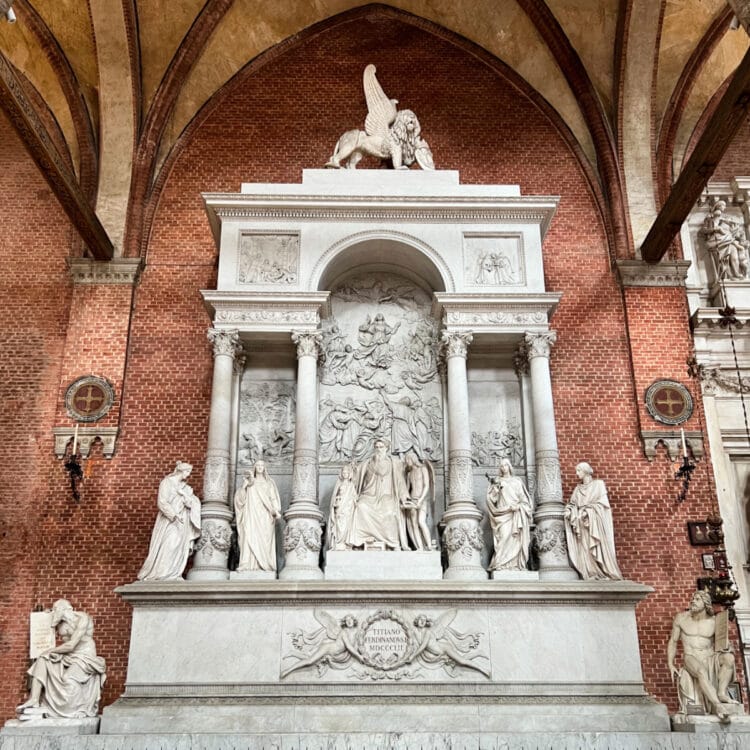
Titian died in 1576 during a plague outbreak, and his burial inside the Frari was a rare honor. His Pieta, however, was not acceptable to the Franciscans. The painting was removed from Titian’s original burial chapel (and is now in the Accademia.)
The monumental tomb now honoring Titian was only commissioned in the mid-19th century by Emperor Ferdinand I of Austria. Designed by Luigi and Pietro Zandomeneghi, the structure is richly ornamented and filled with symbolic detail.
At the center is a statue of Titian, surrounded by allegorical figures representing the arts. The five high-relief carvings depict his famous paintings, including, at the center, the local Assumption.
The design reflects the esteem in which Titian was held, not just in Venice, but across Europe. It is a Romantic-era tribute to the artist’s enduring legacy. However, as with similar monuments in Santa Croce in Florence, it is more a curiosity than an artistic highlight.
Canova’s Tomb
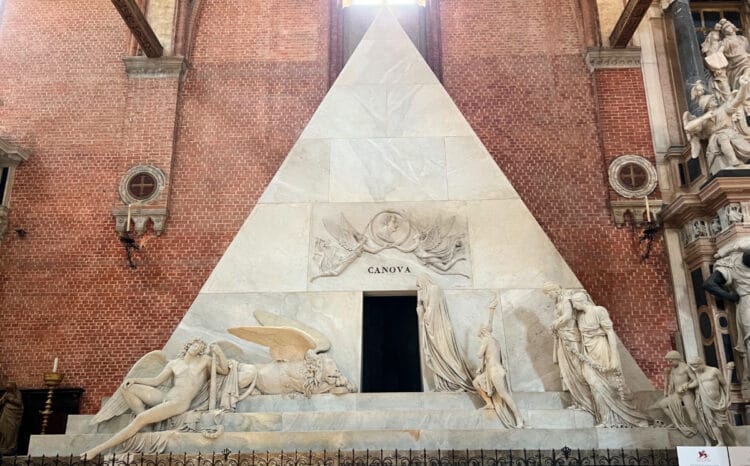
Nearby is the tomb of the great Neoclassical sculptor Antonio Canova (1757-1822). His students erected it based on a design Canova had previously suggested for a monument to Titian. The result is an extraordinary structure: a towering marble pyramid with a dark doorway at its base and allegorical figures ascending the steps.
One of the most striking elements is the mourning lion at the base, representing Venice itself. The figures include mourners carrying an urn with Canova’s heart. (He is buried in Possagno, but his right hand is in the Accademia.)
The tomb is both austere and emotional, blending classical clarity with personal symbolism. It offers a powerful counterpoint to the surrounding Renaissance works, although it appears somewhat out of place in the Gothic surroundings.
A model of Canova’s original pyramid design is in the Galleria dell’Accademia. Although this suggestion for a funeral monument to Titian was never erected, Canova used a similar design for the monument of Maria Christina of Austria in the Augustinerkirche in Vienna.
Monuments to the Pesaro Family

The Pesaro family played an important role in the construction and decoration of the church. They had several monuments here — most famously the Pesaro altar with Titian’s Madonna Ca’Pesaro painting.
Doge Giovanni Pesaro’s tomb in the nave, designed by Baldassare Longhena in the 1660s, is a towering cascade of black and white marble, gilded skeletons, twisted columns, and heroic figures.
Supported by four gigantic Moors carved from dark stone, the tomb rises upward in increasingly ornate layers. Allegories, cherubs, and columns frame a statue of the Doge seated in state. The result is a masterpiece of Venetian Baroque style—flamboyant, theatrical, and filled with complex symbolism.
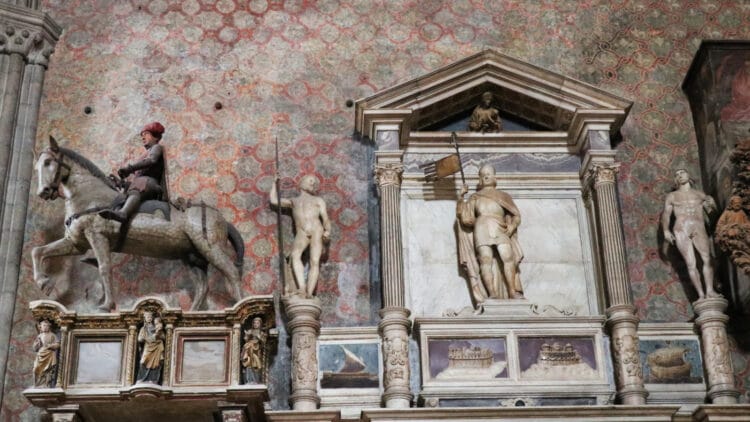
Also interesting is the Monument to the sea captain Benedetto Pesaro, 1503, above the door leading to the sacristy. His sculpture is flanked by the nude gods Mars and Neptune. The Madonna and Child on the tympanum are the only Christian symbols in the whole monument.
Next to it is the funerary monument to Paolo Savelli, 1405. This Gothic work was the first equestrian statue dedicated to a soldier of fortune in Venice. The horse and rider are in gilded and polychrome wood. Donatello produced his famous bronze Gattamelatta in Padua around 50 years later.
Tomb of Claudio Monteverdi
In contrast to the grandeur of the Pesaro tomb, the grave of Claudio Monteverdi is marked only by a modest stone slab — transept, far left. Monteverdi, one of the founding figures of opera, died in Venice in 1643.
Although simple, the tomb carries immense cultural weight. Monteverdi’s contributions to sacred and secular music changed the course of Western composition.
Choir Stalls and Wood Inlays

The 15th-century choir stalls carved by Marco Cozzi and the rood screen are the only set still in position of any major church in Italy. These wooden seats, arranged in two levels, include a stunning array of inlaid panels depicting saints, biblical stories, and ornamental patterns.
Each panel is a masterpiece of intarsia (wood inlay), demonstrating the precision and artistry of Venetian craftsmanship. The stalls not only served a liturgical function but also created an environment that reflected the harmony and richness of the Renaissance ideal.
Visitor’s Information for the Frari Church

Opening Hours
Opening hours for the Frari Church for tourist visits are as follows:
- Sundays and holidays: 13:00 to 18:00
- Saturdays: 9:00 to 18:00
- Weekdays: 9:00 to 18:00 (19:30 from Easter to October 31)
The Frari closes only to tourists during Christmas, Easter, and August 15 (Assumption of the Virgin).
As a working church, it may also close for funerals, weddings, baptisms, and concerts.
Tickets to Visit the Frari
Admission tickets to the Frari are €5 for adults. Seniors over 65 pay €3, while youths (any nationality) may enter for €2. Only children up to 11 years old enter for free.
A half-hour audio guide is available for €2. Download the brochure or floor plan map from the official website.
Tickets are sold onsite only and without time-slot reservations. Entry is usually quick. Even on days when the time-slot reservation tickets for San Marco sell out weeks in advance, visitors simply stroll into the Frari at leisure to enjoy the fantastic art.
Transportation to the Frari
The Basilica Santa Maria Gloriosa dei Frari, San Polo, 3072, 30125 Venezia VE, Italy, is located a few blocks off the Grand Canal, roughly halfway between the Galleria dell’Accademia and the train station. The closest vaporetto stop is S. Toma (lines 1 & 2) on the Grand Canal, with easy links to the station and San Marco.
Walking, if not getting lost, takes around 15 minutes from the station or Galleria dell’Accademia, and 20 minutes from St. Mark’s Basilica and the Doge’s Palace (cross at Rialto).
The Scuola Grande di San Rocco, with its magnificent cycle of 60 Tintoretto paintings, is directly behind the Frari.
